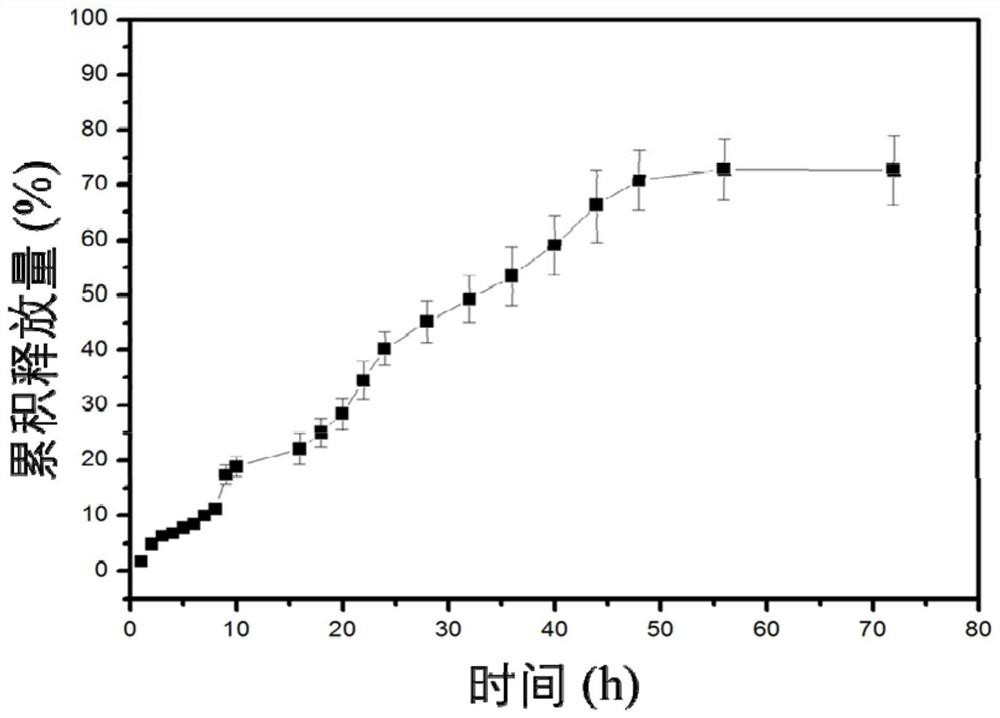Nano preparation for targeted cardiac repair and preparation method thereof
A nano-preparation and targeting technology, applied in the field of biomedical engineering materials, can solve the problems of normal cell toxicity, non-regeneration of cardiomyocytes, damage to heart function, etc.
- Summary
- Abstract
- Description
- Claims
- Application Information
AI Technical Summary
Problems solved by technology
Method used
Image
Examples
Embodiment 1
[0035] Embodiment 1: Coenzyme Q 10 - Preparation of NEs-TPGS-Arg
[0036] First, add 2g of coenzyme Q 10 Heat and melt in a constant temperature water bath at 60°C to form liquid coenzyme Q 10 Oil phase; subsequently, 2g of soybean phosphatidylcholine, 1g of arginine-modified polyethylene glycol 1000 vitamin E succinate (TPGS-Arg), 70g of glycerin and 25ml of deionized water were placed in a 50°C beaker, heated and stirred at constant temperature Until the soybean phosphatidylcholine is completely dissolved to form an aqueous phase; finally, the liquid coenzyme Q 10 Add the oil phase to the water phase, heat and stir at 50°C for 20 minutes, ultrasonically disperse for 2 hours to form a transparent and clear microemulsion, and obtain coenzyme Q after cooling 10 -NEs-TPGS-Arg, kept airtight.
Embodiment 2
[0037] Embodiment 2: Coenzyme Q 10 Preparation and Characterization of -NEs-TPGS-Arg / Pterostilbene Nanoparticles
[0038] Take 1g of coenzyme Q prepared above 10 -NEs-TPGS-Arg, add 3 mg of pterostilbene, ultrasonically disperse for 5 min, and stir at room temperature for 4 h to obtain a clear and transparent colloidal solution. Characterization of Coenzyme Q by Fourier Infrared Spectroscopy 10 -The characteristic peak changes of NEs-TPGS-Arg / pterostilbene nanoparticles before and after drug loading. FTIR Fourier transform infrared spectroscopy is a spectrum that shows molecular vibrations. It can identify the functional groups in the substance to be tested. The infrared test of the products and raw materials obtained in each step can prove whether the target product has been successfully synthesized. Take an appropriate amount of the substance to be tested (i.e. the coenzyme Q prepared in Example 1) 10 -NEs-TPGS-Arg, the Q10-NES-TPGS / pterostilbene nanoparticle that embodim...
Embodiment 3
[0039] Embodiment 3: coenzyme Q 10 Preparation and Characterization of -NEs-TPGS-Arg / Pterostilbene Nanoparticles
[0040] Take 2g of coenzyme Q prepared above 10 -NEs-TPGS-Arg, add 6mg of pterostilbene, ultrasonically disperse for 5min, and stir at room temperature for 4h to obtain a clear and transparent colloidal solution. Coenzyme Q at different scales detected by transmission electron microscopy 10 - Transmission electron microscope image of NEs-TPGS-Arg / pterostilbene nanoparticles. from figure 2 It can be seen in the figure that the nanoparticles are spherical, the particle size is relatively uniform, the particle size is between 60-80nm, and there is no adhesion to each other.
PUM
| Property | Measurement | Unit |
|---|---|---|
| Particle size | aaaaa | aaaaa |
Abstract
Description
Claims
Application Information
 Login to View More
Login to View More - R&D
- Intellectual Property
- Life Sciences
- Materials
- Tech Scout
- Unparalleled Data Quality
- Higher Quality Content
- 60% Fewer Hallucinations
Browse by: Latest US Patents, China's latest patents, Technical Efficacy Thesaurus, Application Domain, Technology Topic, Popular Technical Reports.
© 2025 PatSnap. All rights reserved.Legal|Privacy policy|Modern Slavery Act Transparency Statement|Sitemap|About US| Contact US: help@patsnap.com



